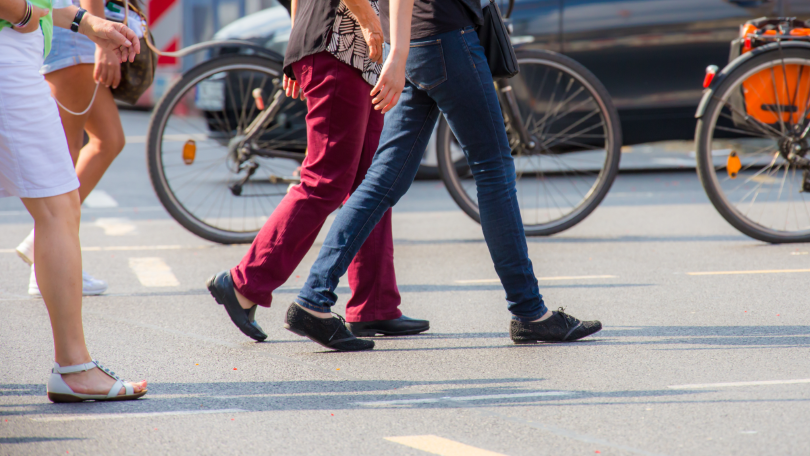
Source: Adobe Stock / Rainer Fuhrmann
Walking is the oldest and most popular form of movement. More than 80 % of Germans like or even enjoy walking. Almost one third of journeys is undertaken on foot. Walking is becoming ever more important to maintain everyday mobility, in particular among women, older people and children: these groups of the population walk most often. ¬The share of walking is highest among over 80-year-olds with 34 %.
Walking is not only an independent type of traffic, but also a component of every other form of mobility, since it connects different modes of transport. In strengthening ecomobility, i.e. the combination of public local transport, cycling and pedestrian traffic, walking plays a central role and goes beyond just getting to the next public transport stop. Therefore, walking has to be a fundamental component of any kind of mobility strategy. In this context, walking, on the whole, has to become safer and more attractive.
The Federal Ministry for Digital and Transport will develop a Pedestrian Traffic Strategy in cooperation with experts and the federal states. The objective is to improve the traffic conditions for pedestrians in Germany by strengthening the safety and attractiveness of pedestrian traffic at all federal levels as part of modern mobility.
Promoting pedestrian traffic
With the adoption of the 2022 Federal Budget, the Federal Ministry for Digital and Transport will be funding pedestrian traffic for the first time. For 2024, investment and non-investment funding for pedestrian traffic totalling 2.5 million euros has been earmarked. The aim is to promote pedestrian-friendly model projects for instance for street area design and model crossing facilities. The Federal Office for Goods Transport is the developer.
The Federal Ministry for Digital and Transport is promoting pedestrian traffic at interfaces with other modes of transport, too. To promote the safety and attractiveness of pedestrian traffic, measures from different fields of actions are taken:
- As part of its National Cycling Plan (NCP), the Federal Ministry for Digital and Transport is promoting seven non-investment model projects at the walking-cycling interface with a total of more than 2.8 million euros.
For more information please visit the Federal Mobility Forum. - Seven more projects related to pedestrian traffic are being funded within the scope of the mFUND innovation programme. For more information please visit the mFUND subject overview
- The Federal Highway Research Institute is currently doing research on pedestrian traffic in nine projects. Nine new projects are being prepared, e.g. to determine the number of pedestrians through censuses that cover a short period of time and surrounding data.
- With its ‘Digitalization of local authority transport systems’, the Federal Ministry for Digital and Transport is providing financial assistance to promote the digital transformation of urban mobility as well as health and climate action. The programme helps progress digital mobility solutions for cities and municipalities. Currently, there are four programmes focused on finding out how to improve pedestrian traffic.
- The Research Programme on Automation and Connectivity in Road Transport is focused on transport and social policy issues related to automated driving. Currently, there are nine projects in this field which also do research on questions relevant to walking.
- Within the framework of capital investment model projects, 28 projects are currently funded by the Federal Ministry for Digital and Transport, e.g. the construction of foot and cycle path bridges, tunnels or crossing facilities, which also help improve pedestrian traffic.
The Federal Cabinet has adopted the new Federal Government Road Safety Programme for the time between 2021 and 2030. One focus of the programme is on safe walking. This area is not only reflected in a separate field of action. Pedestrian traffic is included and seen as an essential element in the other thematic focus areas.
The specific measures of the Road Safety Programme will be oriented towards the priority areas of accidents, since they have the highest potential for reducing the number of fatalities. In built-up areas, this affects mostly pedestrians, who, as unprotected road users, are at higher risk. Here, the focus should be mainly on measures to protect elderly road users.
As part of the Directive on the promotion of measures for the improvement of road safety, the BMDV is also supporting various awareness-raising projects to increase the safety of pedestrians. The educational programmes for parents and senior citizens, also known as moderator programmes of the German Road Safety Council and the German Accident Prevention Organization, for instance, put a focus on walking.
Furthermore, in 2021, a campaign that had been running for 2 years called ‘Safely mobile in old age’ was continued. The campaign promotes treating the older generation with consideration. A campaign on the use of e-scooters focuses on safe parking of scooters on pavements.
For more information on the Road Safety Programme 2021 to 2030 please the visit the German Road Safety Council website (see FURTHER INFORMATION).